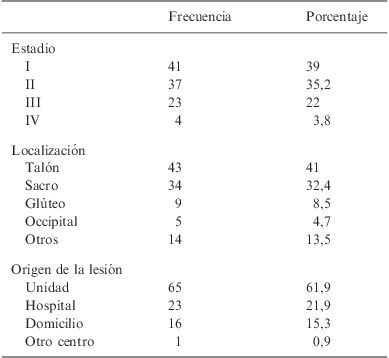Las úlceras por presión (UPP) constituyen uno de los efectos adversos ligados a la hospitalización. En consecuencia se plantean los siguientes objetivos: determinar la prevalencia de las UPP en pacientes ingresados en un hospital terciario, describir las características de las lesiones, conocer la utilización de superficies especiales de manejo de la presión (SEMP) y establecer líneas de actuación para su disminución.
MétodoEstudio descriptivo, trasversal, de prevalencia en pacientes adultos ingresados entre el 11 y el 15 de mayo del 2009. Variables: demográficas, número de UPP, unidad de ingreso, nivel de riesgo (escala de Gosnell modificada), estadio, localización, causa, origen de la lesión, utilización de SEMP.
ResultadosSe estudiaron 682 pacientes, 70 (10,3%) de los cuales presentaron al menos una lesión.
El riesgo de aparición de UPP en los pacientes valorados como alto riesgo es muy superior al de los pacientes valorados sin o de bajo riesgo (OR: 6,26 IC 95% 3,54–11,08; p<0,001).
La mayor parte de las lesiones fueron estadio i (39,1%) y estadio ii (35,2%), localizadas mayoritariamente en talón y sacro. El 83,8% de las UPP tuvieron origen intrahospitalario y la causa principal fue la presión (99%). Solo se utilizaron el 28,1% de las SEMP disponibles.
ConclusionesEl porcentaje global es más elevado con lesiones menos graves. Se debe identificar y aplicar medidas preventivas precozmente en los pacientes de mayor riesgo. En nuestro medio, la utilización de las SEMP es escasa en relación a los pacientes de riesgo.
The pressure ulcers (PU) are one of the adverse effects associated with hospitalisation. The aims of this study are, to determine the prevalence of PU in patients admitted to a tertiary hospital, to describe the characteristics of the injuries, to find out the frequency of use of special surfaces for managing pressure (SSMP), and to establish lines of action for their prevention.
MethodThis is a cross-sectional study of adults patients admitted to hospital between May 11 and 15, 2009. Collected variables are: demographic data, number of PU, admission unit, risk level (measured by modified Gosnell′s scale), stage, location, cause, origin of the injury and SSMP.
ResultsA total of 683 patients were studied, of which 70 (10.3%) of them had at least one wound. The risk of developing PU in patients evaluated as high risk, is more than those patients evaluated as no or low risk (OR: 6.26; 95% CI; 3.54–11.08; p<0.001).
Most of the wounds they were stage i (39.1%) and stage ii (35.2%), located mostly in the heel and sacrum, and (83.8 %) of the PU were of hospital origin. Only 28.1% of the available SSMP were used.
ConclusionsThe overall percentage of PU is greater than that reported in other studies, but with less severe injuries. Patients at risk need to be identified and early preventive measures applied. In our hospital the use of SSMP is low in relation to the number of patients at risk.








